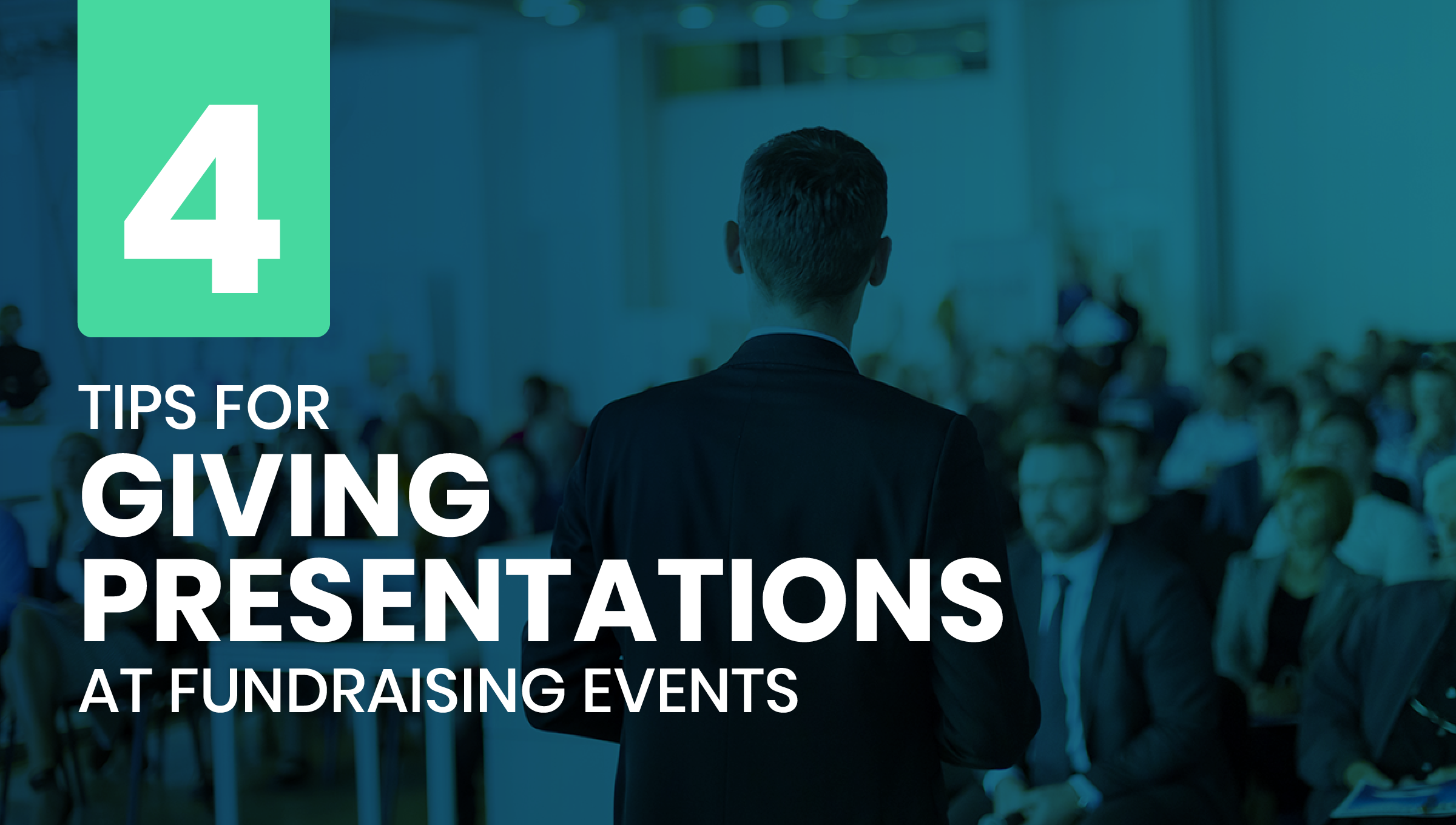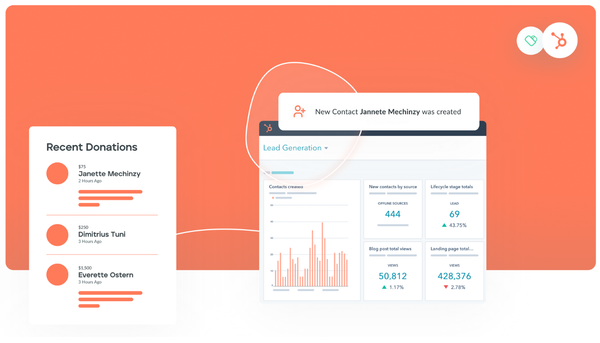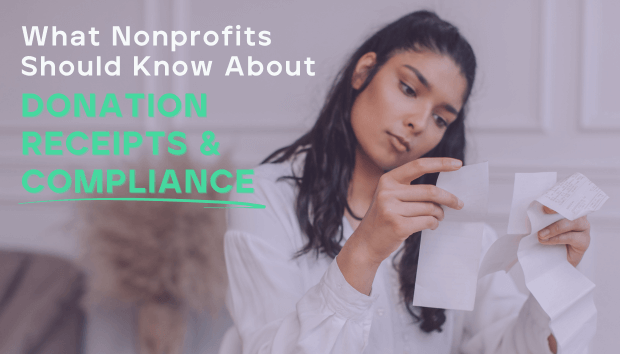4 Tips for Giving Presentations at Fundraising Events
Fundraising events are a great opportunity to present about your nonprofit and engage your audience. Here are some tips for giving an engaging presentation.

Imagine this: it’s the end of the year, and you’re at a fundraising event. Your nonprofit has reached an important goal through a successful peer-to-peer fundraising campaign, and has invited all the major donors to celebrate. Attendees are mingling, enjoying free refreshments, and listening to a live band. This is a great opportunity to give a quick fundraising presentation that thanks audience members for attending and highlights why their support is so critical to your nonprofit’s mission.
In this guide, we’ll review four tips for making your presentation impactful and memorable:
1. Speak to your unique audience.
2. Make your presentation concise.
3. Incorporate audience interaction.
4. Highlight multiple ways to give.
Preparing for a presentation can be nerve-wracking. If the idea of presenting at a fundraiser intimidates you, Be Brilliant has some useful tips. One of the most important things to keep in mind while preparing is to have a concrete idea of who your audience is. Let’s take a closer look at how researching your audience and following other speaking best practices can make your presentations more relevant and useful.
1. Speak to your unique audience.
Just like every fundraising event has a different purpose and goal, every event also has a different audience with unique motivations and interests. It’s crucial that your presentation is interesting to your attendees, ensuring their continued enthusiasm for your event and your nonprofit as a whole.
Consider the people who are attending your event. They may include:
- Potential or current donors
- Volunteers
- Potential or current corporate sponsors
- General community members
Research your audience members ahead of time to understand their motivations and interests. You can use tools such as your donor management system or social media platforms like LinkedIn to help understand your audience’s demographics, employment information, and charitable giving history.
Then, you can develop a presentation that speaks to their interests and preferences. This will make your presentation much more engaging and personalized to your unique audience. For example, if your audience is mostly potential corporate sponsors, you could highlight the benefits of corporate social responsibility, such as an improved positive image in the community. You could also talk about future events or campaigns that your audience would want to participate in.
It can be tempting to center your presentation on your nonprofit’s goals and the good you’re doing for the community. However, by appealing to your audience’s interests with your presentation, you will ensure a higher rate of engagement in the future. Be thorough with your audience research to guarantee a presentation that will interest them.
2. Make your presentation concise.
While people have many reasons for attending fundraising events, such as giving back to the community or making a donation, one of the main reasons is to have fun and enjoy themselves. Your presentation, while important, is probably not the primary focus of the event. Make sure to keep it short and to the point so that people can go back to enjoying the main event.
Here are a few ways to keep your presentation concise:
- Storyboard your presentation ahead of time. Planning out exactly what you want to say will help you stick to the highlights and avoid rambling or going off script. Make sure you practice so you feel confident and prepared.
- Connect supporters’ participation to a tangible impact on your mission. Giving a concrete impact will give supporters a better understanding of the effect their donations have. For example, let them know that all of their donations throughout your event will benefit your organization’s volunteer program, allowing you to purchase more supplies.
- Keep your speech to only a few minutes. Event attendees will want to get back to the festivities, so make sure your speech is short and sweet to maintain their attention. By keeping your speech short, attendees will be more engaged while it’s happening and will appreciate that you’re being respectful of their time.
A key takeaway is that while your presentation is not the main focus of the event and should not take too long, it should still be interesting and engaging. If you know you have a presentation coming up at a fundraising event, make sure you brush up on your presentation rehearsal skills to put your best foot forward.
3. Incorporate audience interaction.
When done well, audience interaction can increase attendees’ interest in your presentation and keep their attention on you. This is a great way for your audience to feel included. Here are a few ways you can interact with your audience in your presentation:
- Take a poll or a show of hands. This engagement method is incredibly easy to add to your presentation. For example, you might ask attendees to raise their hands if they participated in your event as a peer-to-peer fundraiser or if they’ve volunteered for your organization in the past.
- Ask attendees to fill out a survey after the event. According to MemberClicks, some great questions to ask include, “How would you rate the event?” “What suggestions do you have to improve future events?” and “On a scale of 1-10, how convenient did you find our donation process?”
Having audience interaction in your fundraising event presentation will ensure that your audience remains interested and engaged in your presentation. It can also be a great way for you to get valuable feedback from event participants that will help you improve your future events.
4. Highlight multiple ways to give.
When you give a presentation or speech, people are most likely to remember what you said at the very end. Highlighting different ways to give at the end of your speech solidifies that information in your audience’s minds and encourages them to consider giving in a different way.
A few giving options you can mention in your wrap-up include:
- Your organization’s main online donation page. You can offer the link or a QR code for event attendees to quickly visit your online giving page. Make sure that this page is mobile optimized, so that anyone wanting to make a donation at the end of your presentation can do so easily.
- Peer-to-peer fundraising campaign pages. If your event is focused on finishing up your peer-to-peer fundraising campaign, you can encourage attendees to continue giving to participants’ online fundraising pages throughout the event.
- Cash or check donations. You might also offer donation boxes throughout your event space for attendees to contribute cash donations. Spread these out throughout the venue so that they are easily accessible to attendees.
Be sure to smoothly integrate giving methods into your presentation to seem natural. Remember that the fundraising event is a celebration and take care not to appear too greedy. Your attendees are potential donors, and you should make an effort to make them feel special.
Fundraising events are a wonderful opportunity to give short presentations about your nonprofit, the impact your donors’ gifts are having, and get feedback on your event in general. If you still feel intimidated by this prospect, don’t worry—remember that your audience, no matter how diverse, is interested in your nonprofit and likely wants you to succeed. As long as your presentation is engaging and brief, it will be a great success.





